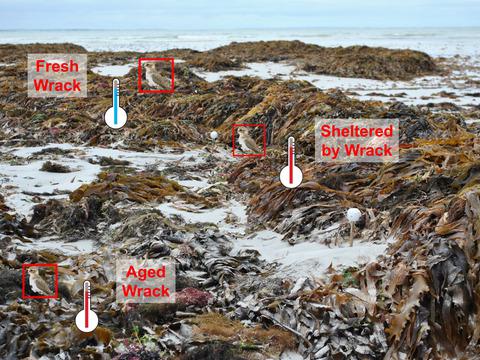当前位置:
X-MOL 学术
›
J. Appl. Ecol.
›
论文详情
Our official English website, www.x-mol.net, welcomes your
feedback! (Note: you will need to create a separate account there.)
Fine-scale environmental heterogeneity and conservation management: Beach-cast wrack creates microhabitats for thermoregulation in shorebirds
Journal of Applied Ecology ( IF 5.0 ) Pub Date : 2021-03-31 , DOI: 10.1111/1365-2664.13865 Timothy John Davis 1 , Gunnar Keppel 1, 2
中文翻译:

精细尺度的环境异质性和保护管理:海滩铸造残骸为滨鸟的体温调节创造了微栖息地
更新日期:2021-06-02
Journal of Applied Ecology ( IF 5.0 ) Pub Date : 2021-03-31 , DOI: 10.1111/1365-2664.13865 Timothy John Davis 1 , Gunnar Keppel 1, 2
Affiliation

|
- Conservation management to protect coastal ecosystems sometimes overlooks site-specific fine-scale heterogeneity. For example, while habitat loss is a known key driver of population declines in many shorebirds, these birds are also dependent on high-quality habitats to maximize energy stores. Here we describe the microhabitats provided by beach-cast wrack (washed up macroalgae and seagrasses), a resource threatened by harvesting and beach cleaning, and how shorebirds utilize these.
- We measured the temperature and absolute humidity at 10 cm above three substrates (fresh wrack, aged wrack and sand) and then related bird behaviour (roosting vs. foraging) to climatic and environmental data.
- Freshly beach-cast wrack mostly provided cooler and less humid habitats, but warmer temperatures than aged wrack or sand in the early mornings. Microtopography created by shelter from prevailing winds and wrack depth modified these general trends.
- Generally, temperature predicted where shorebirds overall and the two most common species, the double-banded plover Charadrius bicinctus and red-necked stint Calidris ruficollis, were observed. During most of the day, foraging and roosting were more likely to occur on the warmer aged wrack. In the early morning, when fresh wrack provided the warmer temperatures, birds tended to roost and forage on fresh wrack.
- Synthesis and Applications. Beach-cast wrack creates a complex mosaic of unique microclimates varying in space and time, which allows shorebirds to minimize energy expenditure by selecting the thermally most favourable habitats for roosting and foraging. Removal of beach-cast wrack for commercial and aesthetic reasons thus reduces habitat quality and increases energy expenditure in shorebirds. Associated declines in energy stores may be contributing to declines in shorebird populations. Management of coastal ecosystems and shorebirds therefore needs to consider and maintain fine-scale environmental heterogeneity at local scales.
中文翻译:

精细尺度的环境异质性和保护管理:海滩铸造残骸为滨鸟的体温调节创造了微栖息地
- 保护沿海生态系统的保护管理有时会忽视特定地点的精细尺度异质性。例如,虽然栖息地丧失是许多滨鸟种群数量下降的一个众所周知的关键驱动因素,但这些鸟类也依赖高质量的栖息地来最大限度地储存能量。在这里,我们描述了由海滩铸造残骸(被冲刷的大型藻类和海草)提供的微型栖息地,这是一种受到收获和海滩清洁威胁的资源,以及滨鸟如何利用这些。
- 我们测量了三种基质(新鲜碎屑、老化碎屑和沙子)上方 10 厘米处的温度和绝对湿度,然后将鸟类行为(栖息与觅食)与气候和环境数据相关联。
- 新鲜的海滩铸造残骸大多提供凉爽和不太潮湿的栖息地,但比清晨的陈年残骸或沙子温度更高。避开盛行风和残骸深度形成的微地形改变了这些总体趋势。
- 一般来说,温度可以预测水鸟的总体位置和两种最常见的物种,即双带鸻Charadrius bicinctus和红颈鸻Calidris ruficollis。在一天的大部分时间里,较温暖的老化残骸更有可能发生觅食和栖息。在清晨,当新鲜的残骸提供温暖的温度时,鸟类往往会在新鲜的残骸上栖息和觅食。
- 合成与应用。海滩铸造残骸创造了一个复杂的马赛克,由空间和时间不同的独特小气候组成,这使得滨鸟可以通过选择最适合栖息和觅食的热栖息地来最大限度地减少能量消耗。出于商业和美学原因去除海滩上的残骸会降低栖息地质量并增加滨鸟的能量消耗。能源储备的相关下降可能导致滨鸟种群的下降。因此,沿海生态系统和滨鸟的管理需要考虑并保持局部尺度的精细环境异质性。











































 京公网安备 11010802027423号
京公网安备 11010802027423号